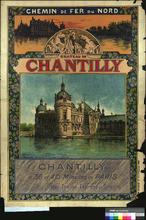1 - 41 of 41 records
Empire Francais et Royaume d'Italie (1812)

Description: Detailed single page historical copper engraved map of the French Empire. This map depicts France, North and Central Italy, Northern Spain, Belgium, Luxembourg, Germany, Switzerland, Monaco, Andorra, San Marino, and parts of Austria, Croatia, Slovenia, England, and Wales. The map shows several geographic details on cities, towns, rivers, mountains, and islands. The map includes an inset map int the top right quadrant showing the Netherlands. The map features a vignette incorporating the title. Cities appearing on this map include: Italy: Domodossola, Sondrio, Bormio, Udine, Spilemberg (Spilimbergo), Tolmezzo, Piave di Cadore (Pieve di Cadore), Bellune (Belluno), Felire (Feltre), Brixen, Pruneken (Bruneck), Sterzing, Bolzano, Meran (Merano), Glurens (Glurns), Cles, Neumarkt, Trente (Trento), Preor (Preore), Brio (?), Cividale, Varallo (Varallo Pombia), Ivree (Ivrea), Santia (Santhià), Chivasso, Turin, Aoste (Aosta), Suze (Susa), Riva (Riva del Garda), Salo (Salò), Schio, Verone, (Verona) Castiglione (Castiglione delle Stiviere), Mantoue (Mantua), Clusone, Lecco, Bergame (Bergamo), Brescia, Chiari, Crema, Verolanova (Verloanuova), Lodi, Cremone (Cremona), Plaisance (Piacenza), Como, Arona, Gallarate, Monza, Milan, Novare (Novara), Vigevano, Pavie (Pavia), Verceil (Vercelli), Casal (Casale Monferrato), Voghera, Ceneda (Vittorio Veneto), Asiago, Bassano (Bassano del Grappa), Trevise (Treviso), Franco (Castelfranco Veneto), Vicenze (Vicenza), Padoue (Padua), Venise (Venice), Este, Adria, Rovigo, Pordenone, Conegliano, Trieste, Gorice (Gorizia), Gradisca (Gradisca d'Isonzo), Aquilija (Aquileia), Valence (Valenza), Marengo (Spinetta Marengo), Alexandrie (Alessandria), Novi (Novi Ligure), Aqui (Acqui Terme), Chiavari, Gene (Genoa), Montenotte (Cairo Montenotte), Savone (Savona), Asti, Alba, Ceva, Coni (Cuneo), Saluces (?), Savigliano, Pignerole (Pinerolo), Ferrare (Ferrara), Cento, Imola, Ravenne (Ravenna), Faenza, Forli (Forlì), Bologne (Bologna), Modene (Modena), Mirandolle (Mirandola), Guastalla, Casalmaggiore, Reggio (Reggio Emilia), Vergato, Fiorenzuola (Fiorenzuola d'Arda), Bobbio, Bardi, Parme (Parma), Fornovo (Fornovo di Taro), Villafranca, Brugnato, Sarzana, Rimini, Cervia, Fermo, Tolentino, Macerata, Ancone (Ancona), Sinigaglia (Senigallia), Fano, Pesaro, Urbino, Jesi, Cagli, Fabriano, Camerino, Assisi, Perugia, Fratta, Arezzo, Mt. Alcino (Montalcino), Massa (Massa Marittima), Sienne (Siena), Volterra, Livourne (Livorno), Pisa, Empoli, Florentis (Florence), Pistoia, Lacques (Lucca), Massa, Port Maurice (Imperia or Porto Maurizio), S. Remo (Sanremo), Mt. Rotonda (Monti Sibillini), Popolo (Popoli), Aquila (L'Aquila), Chieti, Teramo, Ascoli (Ascoli Piceno), Mte. Ailo (Montalto delle Marche), Introdoca (Antrodoco), Rieti, Narni, Civita Castellana, Viterbe (Viterbo), Spoleto, Norcia, Foligno, Todi, Orvieto, Civita Vecchia (Civitavecchia), Toscanella (Tuscania), Acquapendente, Grosseto, Piombino, Porto Ferrajo (Portoferraio), Palo (Ladispoli), Peschio Asseroto, Tivoli, Ostui (Ostia), Rome, Veiletri (Velletri), Frosinone, Astura (Torre Astura), Ponte Corvo (Pontecorve), Terracine (Terracina), and Gaete (Gaeta). San Marino: San Marin (San Marino Cittia). Monaco: Monaco France: Corte, Vico, Calvi, I. Rousse (L'Île-Rousse), S. Florent (Saint-Florent), Bastia, Pto. Vecchio (Porto-Vecchio), Sartene (Sartène), Valinco, Ajaccio, Zicavo, Collioure, Perpignan, Salces (Salses-le-Château), Prades, Ax (Ax-les-Thermes), Foix, and S. Girons (Saint-Girons), Puget-Theniers (Puget Thèniers), Nice, Castellane, Grasse, Frejus (Frèjus), Draguignan, St. Tropez (Saint-Tropez), Toulon, La Ciotat, Marseille, Brignolles (Brignoles), Riez, Aix (Aix-en-Provence), Apt, Forcalquier, Arles, Tarascon, Avignon, Aiguesmortes (Aigues-Mortes), Montpellier, Cette (Sète), Nismes (Nîmes), Sijean (Sigean), Narbonne, Bèziers (Beziers), Lodeve (Lodève), St. Afrique (Saint-Affrique), La Canne (Lacaune), St. Pons (Saint-Pons-de-Thomières), Carcassonne, Limoux, Pamiers, Castelnaudary, Villefranche (Villefranche-de-Lauragais), Toulouse, Lavaur, Castres, Gaillac, Alby (Albi), Condom, Lectoure, Auch, Muret (?), Mirande (?), Lombes (Lombez), St. Gaudens (Saint-Gaudens), Mt. de Mansan (Mont-de-Marsan), St. Sever (Saint-Sever), Pau, Tarbes, Oliron (Oloron-Sainte-Marie), Bagneres (Bagnères-de-Bigorre), Argeles (Argelès-Gazost), Dax, Orthes (Orthez), Bayonne, Mauleon (Mauléon-Licharre), St. Jean de Lux (Saint-Jean-de-Luz), Briancon (Briançon), Embrna (Embrun), Barcelonnette, Digne (Digne-les-Bains), Sisteron, Gap, Corps, Die, Carpentras, Orange, Uzes (Uzès), Viviers, Nyons, Montelimart (Montélimar), Privas, Valence, Vernoux (Vernoux-en-Vivarais), Mende, L'Argentiere (Largentière), Florac, Alais (Alès), Le Vigan, Aurillac, S. Chely (Saint-Chély-d'Apcher), Espalion, Marvejols, Rhodez (Rodez), Milhau (Millau), Gourdon, Figeac, Cahors, Villefranche (Villefranche-de-Rouergue), Montauban, Bergerac, Sarlat (Sarlat-la-Canéda), Villereal (Villeréal), Velleneuve (Villeneuve-sur-Lot), Agen, Castel Sarasin (Castelsarrasin), Nerac (Nérac), Libourne, Bordeaux, La Reolle (La Réole), Langon, Garonne (Meilhan-sur-Garonne), Marmande, Bazas, Roquefort, Lipostey (Liposthey), S. Maurice (Bourg-Saint-Maurice), Moutiers (Moûtiers), Conflans (Albertville), S. Jean de Maurienne (Saint-Jean-de-Maurienne), Grenoble, S. Marcellin (Saint-Marcellin), la Tour du Pin (La Tour-du-Pin), Chambery (Chambéry), Quirieu (Bouvesse-Quirieu), Belley, Annecy, Trevoux (Trévoux), Villefranche (Villefranche-sur-Saône), Lyon, Vienne, St. Etienne (Saint-Étienne), Roussillon (Le Péage-de-Roussillon), Tournon (Tournon-sur-Rhône), Thiers, Montbrison, Ambert, Brioude, Issengeaux (Yssingeaux), le Puy (Le Puy-en-Velay), Riom, Clermont (Clermont-Ferrand), Issoire, Murat, St. Flour (Saint-Flour), Mauriac, Argentat, Brives (Brive-la-Gaillarde), Tulle, Ussel, Aubusson, Bourganeuf, St. Yrieix (Saint-Yrieix-la-Perche), Periqueux (Périgueux), Nontron, Rochechouart, Limoges, Riberac (Ribérac), Barbezieux (Barbezieux-Saint-Hilaire), Blaye, Jonzac, Angouleme (Angoulême), Cognac, St. Jean d'Angely (Saint-Jean-d'Angély), Medoc (Médoc), Lesparre (Lesparre-Médoc), Saintes, Marennes, Rochefort, Pontarlier, Thonon (Thonon-les-Bains), Bonneville, Poligny, Lons le Saunier (Lons-le-Saunier), St. Claude (Saint-Claude), Nantua, Verdun (Verdun-sur-le-Doubs), Chalons (Chalon-sur-Saône), Louhans (Louhans-Châteaurenaud), Macon (Mâcon), Bourg (Bourg-en-Bresse), Autun, Bourbonlancy (Bourbon-Lancy), Charolles, la Palisse (Lapalisse), Roanne, S. Amand (Saint-Amand-Montrond), Moulins, Montlucon (Montluçon), Gannat, Issoudun, Chateauroux (Châteauroux), la Chatre (La Châtre), Boussac, Gueret (Guéret), le Blanc (Le Blanc), Bellac, Chatellerault (Châtellerault), Poitiers, Confolens, Civray, Ruffec, Melle, Niort, Partenay (Parthenay), Bressuire, la Rochelle (La Rochelle), Fontenay (Fontenay-le-Comte), Mareuil (Mareuil-sur-Lay-Dissais), Napoleon (La Roche-sur-Yon), Montaigu, les Sables d'Olonne (Les Sables-d'Olonne), Ensisheim, Belfort, Altkirch, Lure, Baume (Baume-les-Dames), S. Hypolite (Saint-Hippolyte), Jussey, Langres, Champlitte, Vesoul, Gray, Besancon (Besançon), Dole, Beaune, Dijon, Semur (Semur-en-Auxois), Montbard, Chatillon (Châtillon-sur-Seine), Tonnerre, Avallon, Chat Chinon (Château-Chinon), Joigny, Auxerre, Clamecy, Nevers, la Charite (La Charité-sur-Loire), Sancerre, Cosne (Cosne-Cours-sur-Loire), Briare, Gien, Bourges, Romorantin (Romorantin-Lanthenay), Blois, Beaugency, Orleans (Orléans), Loches, Tours, Amboise, Vendome (Vendôme), S. Calais (Saint-Calais), Loudun, Chinon, Saumur, Angers, la Fleche (La Flèche), Tiffauges, Nantes, Beaupreau (Beaupréau), Ancenis, Segre (Segré), Chateaubriand (Châteaubriant), Chat. Gontier (Château-Gontier), Paimbaeuf (Paimbœuf), Savenay, Redon, Ploermel (Ploërmel), Vannes, l'Orient (Lorient), Lauterbourg, Haguenau, Saverne, Strasbourg, Sehlestadt (Sélestat), Colmar, Chat. Salins (Château-Salins), Sarrebourg, Luneville (Lunéville), St. Die (Saint-Dié-des-Vosges), Epinal (Épinal), Commercy, Nancy, Toul, Neufchateau (Neufchâteau), Mirecour, Chaalons (Châlons-en-Champagne), Vitry (Vitry-le-François), Bar (Bar-le-Duc), Vassy (Wassy), Chaumont, Bar sur Seine (Bar-sur-Seine), Arcis (Arcis-sur-Aube), Nogent (Nogent-sur-Seine), Troyes, St. Denis (Saint-Denis), Paris, Coulommiers, Meaux, Corbeil (Corbeil-Essonnes), Melun, Provins, Fontainebleau, Sens, Montargis, Mantes (Mantes-la-Jolie), Versailles, Dreux, Chartres, Etampes (Étampes), Verneuil (Verneuil-sur-Avre), Mortagne (Mortagne-au-Perche), Nogent le Rotrou (Nogent-le-Rotrou), Mamers, Chateaudun (Châteaudun), Falaise, Argentan, Domfront, Alencon (Alençon), Mayenne, le Mans (Le Mans), Vire, Mortain, Granville, Avranches, Fougeres (Fougères), Vitre (Vitré), Laval, Rennes, S. Malo (Saint-Malo), Dinan, Monfort (Montfort-sur-Meu), Napoleonville (Pontivy), Loudeac (Loudéac), Lannion, Guingamp, St. Brieux (Saint-Brieuc), Morlaix, Brest, Chateaulin (Châteaulin), Quimper, Audierne, Wissenburg (Wissembourg), Sarreguemines, Metz, Briey, Thionville, Verdun, Ste. Menehould (Sainte-Menehould), Vouziers, Montmedy (Montmédy), Rethel, Sedan, Mezieres (Charleville-Mézières), Rocroy (Rocroi), Epernay (Épernay), Chat. Thierry (Château-Thierry), Rheims (Reims), Soissons, Laon, la Fere (La Fère), and Vervins, Senlis, Clermont, Compiegne (Compiègne), Montdidier, St. Quentin (Saint-Quentin), Peronne (Péronne), Pontoise, Vernon, Gd. Andelys (Les Andelys), Beauvais, Breteuil (Breteuil-sur-Noye), Amiens, Neufchatel (Neufchâtel-en-Bray), Evreux (Évreux), Bernay, Pt. Audemer (Pont-Audemer), Louviers, Rouen, Yvetot, Fecamp (Fécamp), S. Vallery (Saint-Valery-en-Caux), Dieppe, Lizieux (Lisieux), P. leveque (Pont-l'Évêque), Caen, le Havre (Le Havre), Bayeux, S. Lo (Saint-Lô), Valognes, Coutances, Cherbourg (Cherbourg-Octeville) Givet, Conde (Vieux-Condé), Maubeuge, Avesnes (Avesnes-sur-Helpe), Lille, Hazebrouck, Bethune (Béthune), Douay (Douai), Arras, Cambray (Cambrai), Doulens (Doullens), Treport (Le Tréport), Abbeville, Montreuil, S. Pol (Saint-Pol-sur-Ternoise), Boulogne (Boulogne-sur-Mer), St. Omer (Saint-Omer), Calais and Dunkerque (Dunkirk). Spain: Palamos (Palamós), Alataro, Barcelone (Barcelona), Manresa, Cervera, San Sadurme, Pons (Ponts), Balaguer, Lerida (Lleida), Barbastro, Sarinena (Sariñena), Zuerca (Zuera), Saragosse (Zaragoza), Calatayud, Girone (Girona), Ripoll, Roses, Peralada, Puigcerda (Puigcerdà), Solsona, Uirgel (La Seu d'Urgell), Povla (La Pobla de Segur), Ainsa (Aínsa), Benavarre (Benabarre), Huesca, Jaca, Sanguessa (Sangüesa), Roncevalles (Roncesvalles), Pampelune (Pamplona), Estella (Estella-Lizarra), Malagro (Milagro), Tudela, Vittoria (Vitoria-Gasteiz), Miranda de Ebro, Frias (Frías), Saldana (Saldaña), Savero (Sabero), Leon (León), Fontarabie (Hondarribia), Santestevan (?), S. Sebastien (San Sebastián), Deba, Laredo, Valmaseda (Balmaseda), Santander, S. Pedro (?), Vasieda (?), Llanes, Infiesto, el Campo (Campo de Caso), Riba de Sella (Ribadesella), Willaviciosa (Villaviciosa), and Gixcon (Gijón). Croatia: Fiume (Rijeka), Rovigno (Rovinj), and Omago (Umag). Slovenia: Capo d'Istria (Koper), Stein (Kamnik), and Ratmansdorf (Radovljica). Austria: Ferlach, Volkelmarkt (Völkermarkt), Strasbourg (Straßburg), Clagenfurt (Klagenfurt), Gmund (Gmünd), Villach, Lienz, Altenmarkt (Altenmarkt bei Sankt Gallen), Judenbourg (Judenburg), Unt Haus (?), Rottemann (Rottenmann), Murau, Salzbourg (Salzburg), Radstadt, Damsweg (Tamsweg) Kufstein, Schwaz, Innspruck (Innsbruck), Landek (Landeck), Imst, Bregentz (Bregenz), Feldkirch, Steyr, Linz, Wels, Scharding (Schärding), Ried (Ried im Innkreis), and Braun (Braunau am Inn). Germany: Bergtesgaden (Berchtesgaden), Mittenwald, Schong (Schongau), Kaufbeuren, Memmingen, Moesckirch (Messkirch), Geislingen (Geisingen), Constance (Konstanz), Freybourg (Freiburg im Breisgau), Passau, Wasserbourg (Wasserburg am Inn), Haag (Haag in Oberbayern), Munich, Dingelfing (Dingolfing), Neustadt (Neustadt an der Donau), Ingolstadt, Rain, Augsbourg (Augsburg), Nordlingen (Nördlingen), Ulm, Biberach (Biberach an der Riss), Canstadt (Bad Cannstatt), Carlsruhe (Karlsruhe), Stuttgard (Stuttgart), Tubingen (Tübingen), Gamerdingen (Gammertingen), Ettenheim, Offenbourg (Offenburg), Kehl, Darmstadt, Manheim (Mannheim), Spire (Speyer), Bingen (Bingen am Rhein), Simmern, Kirn, Worms, Kaiserslautern, 2 Ponts (Zweibrücken), Landau, Sarrebruck (Saarbrücken), Birkenfeld, Treves (Trier), Giessen, Weilbourg (Weilburg), Francfort (Frankfurt), Neustadt (?), Siegen, Neu Wied (Neuwied), Coblentz (Koblenz), Mayence (Mainz), Cologne, Siegberg (Siegburg), Juliers (Jülich), Bonn, Blankenheim, Pruym (Prüm), Sinsig (Sinzig), Bitbourg (Bitburg), Dasbourg (Dasburg), Aix la Chapelle (Aachen), Lipstadt (Lippstadt), Arensberg (Arnsberg), Lunen (Lünen), Wesel, Duisbourg (Duisburg), Dusseldorf (Düsseldorf), Creveld (Krefeld), Cleves (Kleve), Munster (Münster), Rees, Borken, Verden, Hoya, Nienburg, Minden, Detlingen (Dötlingen), Cloppenbourg (Cloppenburg), Quakenbruck (Quakenbrück), Osnabruck (Osnabrück), Meppen, Lengen (Lingen), Northorn (Nordhorn), Steinfurt, Travemunde (Travemünde), Lubeck (Lübeck), Lauenbourg (Lauenburg), Lunebourg (Lüneburg), Hambourg (Hamburg), Harbourg (Harburg), Rotenbourg (Rotenburg an der Wümme), Stade, Gluckstadt (Glückstadt), Cuxhaven, Bremerlehe (Bremerhaven), Gestendorf (Geestendorf), Osterholz, Bremen, Oldenbourg (Oldenburg), Jever, Aurich, and Emden. Switzerland: Salz (?), Meyenfeld (Maienfeld), Coire (Chur), Tusis (Thusis), Stans, Dissentis (Disentis), Bellinzone (Bellinzona), Locarno, Ingano (Lugano), Brigg (Brig-Glis), Brienz, Thun, Berne (Bern), Sion, Yverdun (Yverdon-les-Bains), Fribourg, Lausanne, Aubonne, S. Maurice (Saint-Maurice), Nyon, Geneve (Geneva), St. Gall (Sankt Gallen), Appenzell, Frauenfeld, Zurich (Zürich), Glaris (Glarus), Schweitz (Schwyz), Schafhausen (Schaffhausen), Lucerne, Soloure (?), Arau (Aarau), Delemont (Delémont), Bale (Basel), Bienne (Biel/Bienne, Poratrui (Porrentruy), and Neufchatel (Neuchâtel). Czech Republic: Rosenberg (Rožmberk nad Vltavou) Luxembourg: Luxembourg and Diekirck (Diekirch) Belgium: Neufchateau (Neufchâteau), Bouillon, Hasselt, Liege (Liège), Verviers, Malmedy S. Hubert (Saint-Hubert), Huy, Marche (Marche-en-Famenne), Dinant, Namur, Louvain (Leuven), Nivelles, Bruxelles (Brussels), Tournay (Tournai), Mons, Courtray (Kortrijk), Ypres, Peer, Turnhout, Anvers (Antwerp), Malines (Mechelen), Dendermonde, Ecloo (Eeklo), Gand (Ghent), Bruges, Ostende (Ostend), Nieuport (Nieuwpoort), and Furnes (Veurne). Netherlands: Maestricht (Maastricht), Nimegue (Nijmegen), Grave, Bois le Duc ('s-Hertogenbosch), Venlo, Ruremonde (Roermond), Breda, Berg op Zoom (Bergen op Zoom), Middelbourg (Middelburg), Axel, Arnheim (Arnhem), Thiel (Tioel), Dordrecht, Assen, Almeloo (Almelo), Amersfort (Amersfoort), Zutphen, Deventer, Zwol (Zwolle), Kainder (?), Heerenveen, Utrecht, la Have (The Hague), Leyde (Leiden), Amsterdam, Alkmaar, Hoorn, Vlinschoten (Winschoten), Groningue (Groningen), Leeuvarden (Leeuwarden), and Sneek. England: Hastings, New-Shoreham (Shoreham-by-Sea), Chichester, Dorchester, Bridport, Exeter, Plymouth, Launsceston (Launceston), Eddistone (?), Padstow, Penzanes (Penzance), Douvres (Dover), Margate, Canterbury, Colchester, Horsham, Tunbridge (Tonbridge), Windsor, Londres (London), Hertford, Oxford, Reading, Wincester (Winchester), Salisbury, Wells, Bath, Bristol, Glocester (Gloucester), and Bridgewater (Bridgwater). Wales: Caermarthen (Carmarthen). Source publication: Atlas Complet Du Precis De la Geographie Universelle De M. Malte Brun dressee par M. Lapie Capitaine Ingenieur Geographie Pierre M. Lapie (1779-1850) and his son Alexandre Emile Lapie (1809-1850) were French cartographers and engravers active in the early part of the 19th Century. The Lapies were commissioned officers in the French army holding the ranks of Colonel and Caipitan, respectively. Alexander enjoyed the title of "First Geographer to the King", and this title appears on several of his atlases. Both father and son were exceptional engraversand fastidious cartographers. Working separately and jointly they published four important atlases, an 1811 Atlas of the French Empire (Alexander), the 1812 Atlas Classique et Universel (Pierre), the Atlas Universel de Geographie Ancienne et Modern (joint issue), and the 1848 Atlas Militaire (Alexander). They also issued many smaller maps and independent issues. All of these are products of exceptional beauty and detail. Conrad Malte-Brun (1755-1826) was an important late 18th and early 19th Century Danish/French cartographer and revolutionary. Conrad was born in Thisted, Denmark. His parents encouraged him to a career in the Church, but he instead enrolled in the University of Copenhagen. In the liberal hall of academia Conrad became an ardent supporter of the French Revolution and the ideals of a free press. Despite the harsh censorship laws of crown prince Frederick VI, Malte-Brun published numerous pamphlets criticizing the Danish government. He was finally charged with defying censorship laws in 1799 and forced to flee to Sweden and ultimately France. Along with colleague Edme Mentelle, Malte-Brun published his first cartographic work, the Geographie mathematique, physique et politique de toutes les parties du monde (6 volumes published between 1803 and 1807). Conrad went on to found Les Annales des Voyages (in 1807) and Les Annales des Voyages, de la Geographie et de l'Histoire (in 1819). He also founded the Paris Societe de Geographie. In time, Conrad became known as one of the finest French cartographers of his time.
Member of: Antiquarian Maps Collection (1603-1863)
Resource Type: Still Image
Partie Septentrionale de l'Empire Francais (1812)
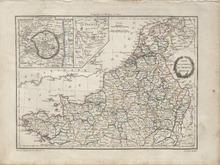
Description: Detailed single page historical copper engraved map of Northern France. The map also covers the Netherlands, parts of Germany, and Switzerland, most of which belonged to the French Empire at the time. The map shows several geographic details on cities, towns, rivers, mountains, and islands. The map includes two inset maps to top left quadrant entitled, "Environs de Paris: and "Holstein". The map features a vignette incorporating the title. Regions shown: Finisterre (Finistère), Morbihan, Loire Inferieure (Loire-Atlantique), Mayenne, Maine et Loire (Maine-et-Loire), Sarthe, Ille et Vilaine (Ille-et-Vilaine), Indre et Loire (Indre-et-Loire), Loir et Cher (Loir-et-Cher), Loiret, Cher, Yonne, Nievre (Nièvre), Cote D'Or (Côte-d'Or), Cotes du Nord, Manche, Orne, Calvados, Eure et Loir, Eure, Seine Inferieure, Seine et Oise, Seine, Seine et Marne, Oise, Aisne, Somme, Pas de Calais, Aube, Haute Marne, Haute Saone, Doubs, Haut Rhin, Vosge, Bas Rhin, Meurthe, Moselle, Meuse, Marne, Ardennes, Forets, Sambre et Meuse, Ourte, Sarre, Mont Tonnerre, Rhin et Moselle, Nord, Lys, Jemappes, Dyle, Escaut, Bouches de L'Escaut, Deux Nethes, Bou de la Meuse, Meuse Inferieure, Oer, Zuiderzee, Yssel Superieur, Bouches du Rhin, Lippe, Frise, Ems Occide, Ems Oriental, Ems Superieur, Bouches du Wesser, and Bouches de L'Elbe. Cities shown: Finisterre (Finistère): Concarneau, Quimperle (Quimperlé), Morbihan: Roche Bernard (La Roche-Bernard), l'Orient (Lorient), Vannes, Ploermel (Ploërmel), Loire Inferieure (Loire-Atlantique): Nantes, Ancenis, and Chateaubriand (Châteaubriant). Mayenne: Chateau Gontier (Château-Gontier), Maine et Loire (Maine-et-Loire): Angers, Segre (Segré), Bauge (Baugé-en-Anjou), and Saumur. Sarthe: Sable (Sablé-sur-Sarthe), la Fleche (La Flèche), S. Calais (Saint-Calais), Ille et Vilaine (Ille-et-Vilaine): Redon, Indre et Loire (Indre-et-Loire): Chateau Regnault (Château-Renault) and Tours. Loir et Cher (Loir-et-Cher): Montdoubleau (Mondoubleau), Vendome (Vendôme), Blois, and Romorantin (Romorantin-Lanthenay). Loiret: Beaugency, Meun (Meung-sur-Loire/Meung), Orleans (Orléans), Sully (Sully-sur-Loire), Briare, Gien, Chateau Renard (Château-Renard), Montargis, Cher: Sancerre. Yonne: S. Fargeau (Saint-Fargeau), S. Sauveur (Saint-Sauveur-en-Puisaye), Nievre (Nièvre): Cosne (Cosne-Cours-sur-Loire) and Clamecy. Cote D'Or (Côte-d'Or): Semur (Semur-en-Auxois), Montbard, Chatillon (Châtillon-sur-Seine), Recey (Recey-sur-Ource), Chanceaux, and Dijon. Source publication: Atlas Complet Du Precis De la Geographie Universelle De M. Malte Brun dressee par M. Lapie Capitaine Ingenieur Geographie Pierre M. Lapie (1779-1850) and his son Alexandre Emile Lapie (1809-1850) were French cartographers and engravers active in the early part of the 19th Century. The Lapies were commissioned officers in the French army holding the ranks of Colonel and Caipitan, respectively. Alexander enjoyed the title of "First Geographer to the King", and this title appears on several of his atlases. Both father and son were exceptional engraversand fastidious cartographers. Working separately and jointly they published four important atlases, an 1811 Atlas of the French Empire (Alexander), the 1812 Atlas Classique et Universel (Pierre), the Atlas Universel de Geographie Ancienne et Modern (joint issue), and the 1848 Atlas Militaire (Alexander). They also issued many smaller maps and independent issues. All of these are products of exceptional beauty and detail. Conrad Malte-Brun (1755-1826) was an important late 18th and early 19th Century Danish/French cartographer and revolutionary. Conrad was born in Thisted, Denmark. His parents encouraged him to a career in the Church, but he instead enrolled in the University of Copenhagen. In the liberal hall of academia Conrad became an ardent supporter of the French Revolution and the ideals of a free press. Despite the harsh censorship laws of crown prince Frederick VI, Malte-Brun published numerous pamphlets criticizing the Danish government. He was finally charged with defying censorship laws in 1799 and forced to flee to Sweden and ultimately France. Along with colleague Edme Mentelle, Malte-Brun published his first cartographic work, the Geographie mathematique, physique et politique de toutes les parties du monde (6 volumes published between 1803 and 1807). Conrad went on to found Les Annales des Voyages (in 1807) and Les Annales des Voyages, de la Geographie et de l'Histoire (in 1819). He also founded the Paris Societe de Geographie. In time, Conrad became known as one of the finest French cartographers of his time.
Member of: Antiquarian Maps Collection (1603-1863)
Resource Type: cartographic
Isle de Bouin (1648)
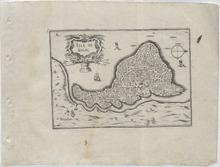
Description: This is a copper engraved map showing houses, roads, and fields of the Island of Bouin. It is decorated with a title cartouche, several sailing ships, and a simple compass rose. It shows the towns of Bouin and Beauoir (Beauvoir-sur-Mer) in the Vendée region of France. It is from the publication: Cartes generals de routes les Provinces de France et d'Espaigen which translates to: General Maps of all the Provinces of France and Spain. It was published in 1648 in Paris, France by Nicolas Berey near the Augustinians. Nicolas Tassin, the cartographer, was active from 1633 until 1655 and was appointed "Royal Cartographer" at Dijon, before setting up as an engraver in Paris where he issued various collections of small maps and plans.
Member of: Antiquarian Maps Collection (1603-1863)
Resource Type: cartographic
Partie Occidentale de l'Empire Francais (1812)
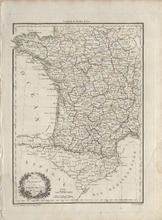
Description: Highly detailed single page historical copper engraved map of the Western part of France and the Northern part of Spain. The map shows several geographic details on cities, towns, rivers, mountains, and islands. The map features a vignette incorporating the title. Regions shown: Pyrenees Orientales (Pyrénées-Orientales), Aude, Arriege (Ariège), Haute Garonne (Haute-Garonne), Hautes Pyrenees (Hautes-Pyrénées), Basses Pyrenees (Pyrénées-Atlantiques), Gard, Herault (Hérault), Aveiron (Aveyron), Tarn, Tarn et Garonne (Tarn-et-Garonne), and Gers. Cities shown: France: Languedoc-Roussillon-Midi-Pyrénées: Pyrenees Orientales (Pyrénées-Orientales): Elne, Pt. Vendre (Port-Vendres), Ceret (Céret), Prats de Mollo (Prats-de-Mollo-la-Preste), Perpignan, St. Paul (Saint-Paul-de-Fenouillet), and Prades. Aude: Leucate, Ouillan (Quillan), Sijean (Sigean), la Grasse (Lagrasse), Narbonne, Castelnaudary, Carcassonne, and Limoux. Arriege (Ariège): Foix, Belesta (Bélesta), Tarascon (Tarascon-sur-Ariège), Ax (Ax-les-Thermes), St. Girons (Saint-Girons), Seix, Pamiers, and Mirepoix. Haute Garonne (Haute-Garonne): S. Beat (Saint-Béat), Bagneres de Luchen (Bagnères-de-Luchon), St. Gaudens (Saint-Gaudens), St. Bertrand (Saint-Bertrand-de-Comminges), Muret, Villefranche (Villefranche-de-Lauragais), Toulouse, Grenade, Caraman, and Villemur (Villemur-sur-Tarn). Hautes Pyrenees (Hautes-Pyrénées): Barreges (Barèges), Argelles (Argelès-Gazost), Lourde (Lourdes), Bagneres (Bagnères-de-Bigorre), la Barthe (La Barthe-de-Neste), Castelnau (Castelnau-Magnoac), Tarbes, and Vic Bigorre (Vic-en-Bigorre). Gard: Avignon, Tarascon, Nismes (Nîmes), Arles, Sommieres (Sommières), St. Hypolitte (Saint-Hippolyte-du-Fort), le Vigan (Le Vigan), and Aiguesmortes (Aigues-Mortes). Herault (Hérault): Montpellier, Frontignan, Cette (Sète), Agde, Pezenas (Pézenas), Lodeve (Lodève), Olargues, Beziers (Béziers), and St. Pens (?). Aveiron (Aveyron): St. Afrique (Saint-Affrique) and S. Sernin (Saint-Sernin-sur-Rance). Tarn: La Caune (Lacaune), Castres, Lavaur, Alby (Albi), Gaillac, and Rabastens. Tarn et Garonne (Tarn-et-Garonne): Beaumont (Beaumont-de-Lomagne), and Montauban. Gers: I'lle en Jourdain (L'Isle-Jourdain), Lombes (Lombez), Monfort, Lectoure, Auch, Simorre, Mirande (?), Vic Fezensac (Vic-Fezensac), Condom, Eauze (Éauze), Nogaro, and Plaisance. Aquitaine-Limousin-Poitou-Charentes: Basses Pyrenees (Pyrénées-Atlantiques): Laruns, Accous, Garlin, Pau, Oleron (Oloron-Sainte-Marie) Landes: Mont de Marsan (Mont-de-Marsan), St. Sever (Saint-Sever), Aire (Aire-sur-l'Adour) Spain: Catalonia: Province of Tarragona: Col de Balaguer (Coll de Balaguer), Perello (El Perelló), Tortose (Tortosa), Amposta, Momblanch (Montblanc), Cornudella (Cornudella de Montsant), Garcia, Miravet, Cambrils, and Tarragone (Tarragona). Province of Girona: Palamos (Palamós), Franciah (?), Tosa (Tossa de Mar), Hostalrich (Hostalric), La Junquiere (La Jonquera), Roses, Figuieres (Figueres), Castel Solit (?), Geronne (Girona), Puycerda (Puigcerdà), Ribas (Ribes de Freser), and Ripoll. Province of Barcelona: Malgrat (Malgrat de Mar), Cadella (Calella), Mataro (Mataró), Gronollers (Granollers), Barcelone (Barcelona), Sitjas (Sitges), S. Feliu (Sant Feliu de Llobregat), Martorell, Olesa (Olesa de Montserrat), Manresa, Cellent (Sallent), and Surla (Súria). Province of Lleida: Basella (Bassella), Pons (Ponts), Balaguer, Llor (?), Lerida (Lleida), Villagrasa (Vilagrassa), Sarroca (?), Urgel (La Seu d'Urgell), Malgrat (?), Castel Leon (?), Tirbia (?), Organya (Organyà), and Talarn. Aragon: Province of Huesca: Barbastro, Venasque (Benasque), Campo, Lastarre (?), Aguilar (?), Lascuare (Lascuarre), Almudorar (Almudévar), Anzanego (Anzánigo), Fiscal, Viescas (Biescas), Jaca, and Ayerbe. Province of Zaragoza: Osero (Osera de Ebro), Mequinenza, Foyon (Fayón), Alfoeea (?), Saragosse (Zaragoza), Escoron (?), Murillo (Murillo de Gállego), and Verdun (Berdún). Navarre: Province of Navarre: Caparroso, Navasques (Navascués), Pampelunne (Pamplona), Roncevalles (Roncesvalles), and Estella. La Rioja: Province of La Rioja: Logrono (Logroño). Castile and León: Province of Burgos: Miranda de Ebro. Basque Country: Province of Álava: Vitoria (Vitoria-Gasteiz). Province of Biscay: Orduna (Orduña). Cantabria: Province of Cantabria: Reynosa (Reinosa). Andorra: Andorre (Andorra la Vella) Source publication: Atlas Complet Du Precis De la Geographie Universelle De M. Malte Brun dressee par M. Lapie Capitaine Ingenieur Geographie Pierre M. Lapie (1779-1850) and his son Alexandre Emile Lapie (1809-1850) were French cartographers and engravers active in the early part of the 19th Century. The Lapies were commissioned officers in the French army holding the ranks of Colonel and Caipitan, respectively. Alexander enjoyed the title of "First Geographer to the King", and this title appears on several of his atlases. Both father and son were exceptional engraversand fastidious cartographers. Working separately and jointly they published four important atlases, an 1811 Atlas of the French Empire (Alexander), the 1812 Atlas Classique et Universel (Pierre), the Atlas Universel de Geographie Ancienne et Modern (joint issue), and the 1848 Atlas Militaire (Alexander). They also issued many smaller maps and independent issues. All of these are products of exceptional beauty and detail. Conrad Malte-Brun (1755-1826) was an important late 18th and early 19th Century Danish/French cartographer and revolutionary. Conrad was born in Thisted, Denmark. His parents encouraged him to a career in the Church, but he instead enrolled in the University of Copenhagen. In the liberal hall of academia Conrad became an ardent supporter of the French Revolution and the ideals of a free press. Despite the harsh censorship laws of crown prince Frederick VI, Malte-Brun published numerous pamphlets criticizing the Danish government. He was finally charged with defying censorship laws in 1799 and forced to flee to Sweden and ultimately France. Along with colleague Edme Mentelle, Malte-Brun published his first cartographic work, the Geographie mathematique, physique et politique de toutes les parties du monde (6 volumes published between 1803 and 1807). Conrad went on to found Les Annales des Voyages (in 1807) and Les Annales des Voyages, de la Geographie et de l'Histoire (in 1819). He also founded the Paris Societe de Geographie. In time, Conrad became known as one of the finest French cartographers of his time.
Member of: Antiquarian Maps Collection (1603-1863)
Resource Type: cartographic
Extrait des Registres du Parlement
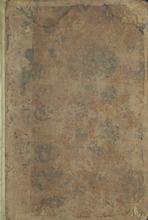
Description: Extrait des Registres du Parlement, du jeudi 29 décembre 1763 du matin, toutes les chambres assemblées. -- Du samedi 31 xbre 1763. -- Du mercredi quatre janvier 1764. -- Du lundi neuf janvier 1764. -- Du mercredi 11 janvier 1764. -- Du samedi 14 janvier 1764. -- Du lundi seize janvier 1764. -- Du mercredi 18 janvier 1764 -- Du lundi 21 janvier 1764 -- Du samedi 21 janvier 1764 -- Extrait des Registres du Parlement , du jeudi 29 décembre 1763 du matin, toutes les chambres assemblées.-- Extrait des Registres des deliberations du Parlement de Toulouse, du mardi 13 décembre 1763 -- Du 14 xbre 1763 -- Du mercredi 16 xbre 1763 -- Du 17 xbre 1763 --Du vendredi 30 xbre 1763 (Paris) -- Du samedi 31 xbre 1763 -- Du mercredi 11 jan[v]ier 1764 -- Du mercredi 18 janvier 1764 -- Du lundi 23 janvier 1764 -- Du samedi 3 mars 1764 -- Du jeudi 8 mars 1764 -- Du lundi 28 may 1764 -- Résultat du travail -- Travail de M.M. les Commisaires -- Mémoire historique sur l'origine, l'essence et les droits de la Pairie et du Parlement, Cour des Pairs -- Pièces justificatives -- Ordonnances -- Erections en Pairies -- Procédures, ârrets et jugements -- Autorités -- Extrait des Registres du Parlement de Paris, du me[r]credi 24 avril 1765 -- Du vendredi 26 avril 1765 -- Arrêté du Parlement de Rouen du 10 août 1764 -- Arrêté du Parlement de Grenoble du 22 mars 1765 -- Arrêté du Parlement de Dauphiné du 22 mars 1765 -- Arrêté du Parlement de Rouen du 19 août 1765 -- Arrêté du Parlement de Paris du 27 août 1770 -- Table des pièces.,[Parlement de Paris]. Mémoire historique sur l'origine, l'essence et les droits de la Pairie et du Parlement, Cour des Pairs / la rédaction de ce mémoire et du résultat du travail est généralement attribué ... à M. Drouyn de Vaudeuil.,Ms. codex.,Script : Written by 2 scribes. Scribe 1 -- main body of the text scribe 2 --notes and comments.,Origin : Written in France in the second half of the 18th cent. apparently for Mr. Drouyn de Vaudeuil, Conseiller des Enquêtes et Requêtes, Parlement de Paris at 1763 and premier président du Parlement de Toulouse 1769-1771.,Bookplate : Ex bibliotheca iacobi Flach in Collegio Franciae Professoris MDCCCLXXXVIII.,On verso of cover written in black ink in minute script apparently by J. Flach : Voyez le jugement que porte le president de [Ministère ?] 1er M. de Voudeuil, dans son [1 word illegible] avec Mme de Pompadour [Remontrances ?], T.ii. Introduction page xxxvi,On verso of cover pasted in citation apparently from a bookseller's advertisement : Mémoire historique sur l' origine, l'essence et les droits de la Pairie et du Parlement, Cour des Pairs. In-fol. cart. Manuscrit du XVIII siècle comprenant environ 400 pp. Ce mémoire, attribué à M. Drouyn de Valdeuil [sic], premier président du parlement de Toulouse, est suivi de pièces justificatives, d'un grand intérêt pour l'histoire de la France, et de plusieurs familles illustres du royaume. En tête du volume se trouve un Extrait des registres du Parlement de Paris, comprenant diverses séances, du jeudi 29 décembre 1763 au mardi 29 mai 1764.
Member of: All Books and Texts
Resource Type: Text
Représentation des fêtes données par la ville de Strasbourg pour la convalescence du Roi
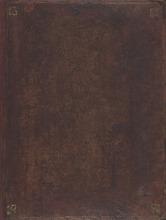
Description: Inventé, dessiné et dirigé par J. M. Weiss, graveur de la ville de Strasbourg.,The Strasbourg Plates folder contains single images for plates that are two-pages in the original.nnEngraved text within borders, at end.nnOriginal is part of the Jacques Flach Collection (University of Missouri--Columbia. Libraries).,Illustrations: title-page engraved by M. Marvie portrait of Louis XV, painted by Parrocel (the head by Chevalier, after the bust by Lemoine), engraved by J. G. Wile 11 plates by Le Bas after Weis (no. 10, engraved by Weis) vignette and ornamental border on p. 1, and vignette on p. 20 of the text. See also Archives alsaciennes d'histoire de l'art, 1923, année 2, pages 140-166.
Member of: Représentation des fêtes données par la ville de Strasbourg pour la convalescence du Roi
Resource Type: Text
JM-155: Madame Caillaux could get expert help over here
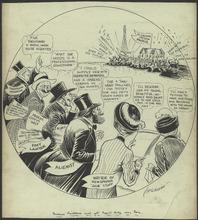
Description: Editorial cartoon depicting the aftermath of the shooting of Gaston Calmette on March 16, 1914. Calmette was a longtime critic of the policies and politics of Joseph Caillaux, the Prime Minister of France, and as editor of the Le Figaro newspaper he published a letter belonging to Caillaux. Henriette Caillaux, a Parisian socialite and second wife of the Prime Minister, believed that Calmette would publish other private letters about the affair she had with her husband while they were both married to other people. Madame Caillaux met with Calmette at his office, shot him six times, and he died six hours later; she was acquitted three months after that because the murder was ruled a crime of passion. This cartoon shows the mass amount of public sympathy for Madame Caillaux in France and the United States. (Summary edited by Mary Delano, MU History Intern, Spring 2018)
Member of: McCutcheon Editorial Cartoons - ALL (Collection)
Resource Type: Still Image
JM-021: Mr. American reactionary abroad tries to change the opinion of Europe

Description: Editorial cartoon depicting an American visiting places such as France, Germany, and Italy and hearing praise for Roosevelt, which the American does not agree with.
Member of: McCutcheon Editorial Cartoons - ALL (Collection)
Resource Type: Still Image
JM-171: Bi-plane dogfight
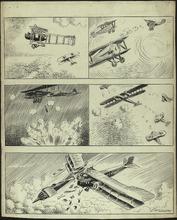
Description: Editorial cartoon depicting five panels of bi-plane dogfight scenes in World War 1. The planes with the iron cross symbol are German planes, while the planes with the roundels are either German or French.
Member of: McCutcheon Editorial Cartoons - ALL (Collection)
Resource Type: Still Image
JM-164: Will there be enough to go round?
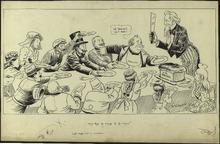
Description: This cartoon depicts Uncle Sam trying to divide "U.S. Bread" among various nations. In 1915, World War I was being fought in Europe, but the United States was maintaining a neutral position. Despite its neutrality, the United States supplied resources and arms to nations during the war. All of the countries sitting at the table are nations who lobbied for resources from the United States during the war. England is attempting to block Germany's chance of receiving resources from Uncle Sam. This is representative the attempts of the British government to limit the United States aid to Allied Powers, most often England. The United States is also sitting at the table, looking worried about sharing the beard with other nations. The United States distributing more resources than it could afford was a fear for many Americans in the 1910s. (Summary created by Mary Delano, MU History Intern, Spring 2018)
Member of: McCutcheon Editorial Cartoons - ALL (Collection)
Resource Type: Still Image
JM-268: Supposing American tourists in France tried to adopt the stalling on the payment plan
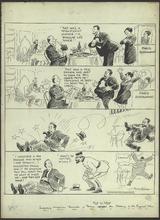
Description: Editorial cartoon depicting an American tourist finishing a large meal at a French restaurant. When he is handed the bill, he offers to pay for it on condition that another man who owes him money pays him back. The restaurant owner kicks the tourist out, and a policeman comes over and asks what happened.
Member of: McCutcheon Editorial Cartoons - ALL (Collection)
Resource Type: Still Image
JM-082: The Siren

Description: Editorial cartoon depicting a figure labeled "Conquest" whispering into the ear of a figure labeled "France" while a third figure, labeled "World Welfare" looks on with a frown and a hand held to her face.
Member of: McCutcheon Editorial Cartoons - ALL (Collection)
Resource Type: Still Image
JM-W022: After you, my dear Air Force
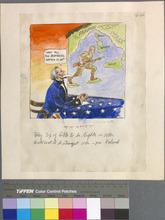
Description: Editorial cartoon depicting Uncle Sam staring at a map of Italian islands where a U.S. soldier is stepping. He says to wait for the bombers to "soften it up."
Member of: McCutcheon Editorial Cartoons - ALL (Collection)
Resource Type: Still Image
JM-272: Make him show his cards
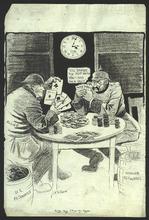
Description: Germany, playing poker with Allies, offers to divide the pot, then quit.
Member of: McCutcheon Editorial Cartoons - ALL (Collection)
Resource Type: Still Image
JM-218: The Turkish victory
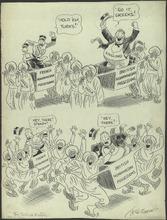
Description: Editorial cartoon depicting the Turkish Victory of 1922, when the Turkish army won the Battle of the Commander-in-Chief against the Greek army on August 30.
Member of: McCutcheon Editorial Cartoons - ALL (Collection)
Resource Type: Still Image
JM-244: Cartoons of the day

Description: Editorial cartoon depicting the cartoons of the day: people searching for Comet K, a family attempting to board a plane to Paris only to find out their flight has been postponed, and Raymond Poincaré, the 58th Prime Minister of France, trying to keep the war hatreds alive.
Member of: McCutcheon Editorial Cartoons - ALL (Collection)
Resource Type: Still Image
JM-282: The interrupted merger
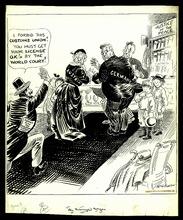
Description: Editorial cartoon depicting the wedding of Austria and Germany stopped by France.
Member of: McCutcheon Editorial Cartoons - ALL (Collection)
Resource Type: Still Image
JM-312: The changing world

Description: Editorial cartoon depicting three scenes of U.S. military and problems caused by foreign states.
Member of: McCutcheon Editorial Cartoons - ALL (Collection)
Resource Type: Still Image
JM-292: Putting a premium on aggression and treaty breaking
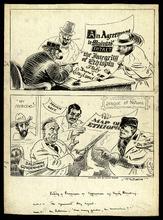
Description: Editorial cartoon depicting Italy, France, and Britain pledging to help Ethiopia, then carve it up.
Member of: McCutcheon Editorial Cartoons - ALL (Collection)
Resource Type: Still Image
JM-077: History of the French Revolution
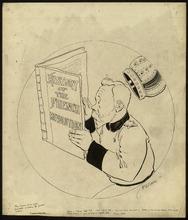
Description: Editorial cartoon depicting a man in a uniform looking wide eyed while reading a book titled "History of the French Revolution." A crown is falling off of the back of his head.
Member of: McCutcheon Editorial Cartoons - ALL (Collection)
Resource Type: Still Image
JM-289: Dancing to the spring song
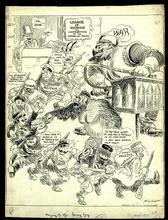
Description: Editorial cartoon depicting men representing nations dancing around "war" organ grinder. The League of Nations watches from a window.
Member of: McCutcheon Editorial Cartoons - ALL (Collection)
Resource Type: Still Image
JM-086: The captain and crew of the William P. Frye, which--
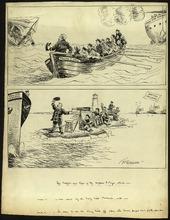
Description: Editorial cartoon depicting a ship labeled the "William P. Frye" being sunk by a ship labeled the "Prinz Eitel Friederich." In the next panel, the crew of the Frye waves the Friederich ship on as it sails to open sea. British cruisers can be seen near the horizon line on the water. The William P. Frye was an American merchant vessel sunk in 1915 after encountering a German ship.
Member of: McCutcheon Editorial Cartoons - ALL (Collection)
Resource Type: Still Image
Réservez le vin pour nos poilus

Description: Poster showing a bottle of wine and grapes.,"Affiche composée par les enfants de France pour la Prévoyance et les Economies. Appel du Comité National de prevoyance et d'économies, Union Française Association Nationale pour l'expansion morale et matérielle de la France.",MU: Poster mounted on linen; stamp "University of Missouri Library Oct 30 1947."
Resource Type: Still Image
Laissez circuler la monnaie d'argent et de billon utile á notre commerce

Description: An overturned jar with coins spilling out of it.
Resource Type: Still Image
Semez du blé
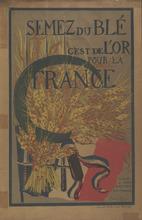
Description: Poster showing a large sickle, a sheaf of wheat, and a French flag in the background.
Resource Type: Still Image
The Humble address of the House of Commons to the Queen
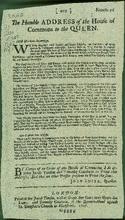
Description: Concerns "the Account of the French King's persisting to Invade Your Dominions ..."Concerns "the Account of the French King's persisting to Invade Your Dominions ...",Caption title.,Leaf signed "Ggggg".
Member of: Broadsides (Collection)
Resource Type: Text
Statuts de L'Ordre de Saint-Michel. Manuscrit qui a été la propriété de Louis XI, Fondateur de L'Ordre.
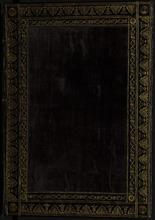
Description: This is a fine copy of the document that defined the practices and rules of the royal Order of St. Michel (the French counterpart to the Burgundian order of the Golden Fleece). Written on vellum, in an elegant script and adorned with illuminated initials, this example was probably copied at the Renaissance court of King Francis I. Bound in nineteenth-century elaborately gilt-tooled black leather over pasteboards incorporating earlier purple velvet binding as center panels on the front and back covers, gilt-tooled spine with five raised bands, purple silk doublures, in very good condition apart from small splits to spine and scuffs to velvet. Dimensions 265 x 185 mm.
Member of: Congressional Research Service
Resource Type: Text
Les environs L'Estang de Longpendu
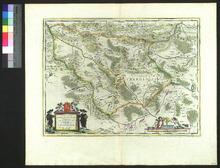
Description: On verso: Text: Caroloesium oder Charolois
Member of: Venable Maps
Resource Type: cartographic
Speech made in the National Convention at Paris on last Friday se'ennight, the 14th of December
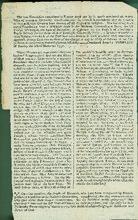
Description: by Citizen Dupont ... ; translated from Le moniteur of Sunday the 6th [sic] of December 1792.,Original speech in French untitled.,Caption title.,Heading begins: The late enormities committed in France need not be so much wondered at ...,Title from ESTC: The following is an exact translation from a speech made in the National Convention at Paris ...,From Le moniteur of Dec. 16, 1792.
Member of: Broadsides (Collection)
Resource Type: Text
France revised and augmented
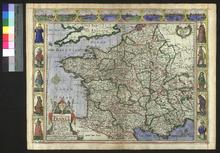
Description: Appeared in Speed's Prospect of the Most Famous Parts of the World (first published in 1627),On verso: Text: The Description of France
Member of: Venable Maps
Resource Type: cartographic
A New Chart of the English Channel, drawn from the Best Authorities. / A New Chart of the Coasts of France and Spain from L'Orient to Gibraltar, Drawn from the Best Authorities
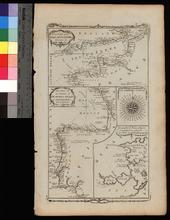
Member of: Venable Maps
Resource Type: cartographic
A New and Correct Map of France
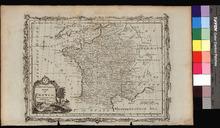
Description: Appeared in Moore's A new and complete collection of voyages and travels (1778).,On verso: Blank
Member of: Venable Maps
Resource Type: cartographic
Map of Central Europe
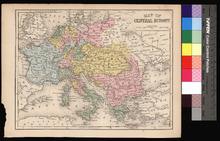
Description: Appeared in Mitchell's New Intermediate Geography (published in various editions between 1869 and 1901). Different editions were produced for different states.,On verso: Text: Great Britain and Ireland (Wales, Ireland)
Member of: Venable Maps
Resource Type: cartographic
Bible. Latin. O. T. Isaiah. [leaf]
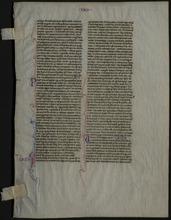
Description: 12mo (17 x 12.3 cm, 6.75 x 4.875"). [1] f.A "Peaceable Kingdom" leaf from a small Bible: Paris was the center of Bible production in the 13th century, with the text having been standardized there, and the University attracting scholars who wished to have just such a small Bible as this leaf came from—a new thing in the 13th century. The text here is Isaiah 61:3-66:10, containing a prophecy of the restoration of Jerusalem, including the well-known Isaiah 65:25: "The wolf and the lamb shall feed together, and the lion shall eat straw like the bullock: and dust shall be the serpents meat. They shall not hurt or destroy in all my holy mountain, saith the Lord."(KJV)nnThis leaf is of very fine paper-thin vellum. The text is in two columns per page of 53 lines, faintly ruled in lead, the top line written below the top rule; it is written in black ink in an extremely small and compact Gothic script of the style typical of Bibles and other scholarly manuscripts of the 13th century. The running headers are in red and blue ink, the numbers heading each chapter are likewise in red and blue, and the 5 two-to-three-line initials (3 on the recto, and 2 on the verso) beginning each chapter are in red or blue, the Q's with long descenders, and all with elaborate long tracery in the contrasting color. A few instructions to the rubricator are to be found in the gutters.nnParchment with slight cockling. Some letters rubbed, affecting legibility in one place. Two pieces of cloth tape, likely for mounting, have been attached in the inner margin of the verso, running beyond the edge of the leaf. The quality and thinness of the parchment, the minuteness of the writing, and quality of the decoration make this a particularly fine, beautiful, and delicate piece.,Full pdf available, https://dl.mospace.umsystem.edu/mu/islandora/object/mu%3A439258/datastream/PDF/view
Member of: Private Collection of Antiquarian Books and Manuscripts
Resource Type: Text
Bible. Latin. N. T. Mark. [leaves]
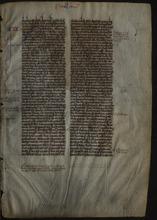
Description: (Mark, chapts. 9-10, including the Transfiguration)nn"ILLUMINATED VELLUM MANUSCRIPT LEAVES FROM A PORTABLE BIBLE IN LATIN. (France, ca. 1250) 5 3/4 x 3 3/4". Double column, 49 lines, written in a tiny gothic book hand. Each leaf featuring capitals struck with red, headlines and verse numbers in blue and red, and one-line versal initials in red or blue. Many leaves with larger (typically four-line) initials in blue or red with elaborate penwork infilling and marginal extension in the same and contrasting colors. SOME LEAVES WITH LARGER INITIALS (typically seven- and nine-lines high) IN DIVIDED RED AND BLUE, OFTEN WITH VERY LONG MARGINAL EXTENSION, sometimes the entire length of the leaf. Most leaves with at least some (and a few leaves with many) MARGINAL ANNOTATIONS IN AN INCREDIBLY TINY HAND. Leaves variably dampstained diagonally across upper portion (sometimes as little as a tenth of the leaf affected, sometimes as much as a third, the discoloration never really absent, but never really dark), vellum a bit cockled, but pleasing leaves nevertheless, the text still quite distinct, the vellum generally clean, and the margins especially ample. Available are a number of leaves from a sizable fragment of a so-called pocket Bible, a 13th century innovation that is discussed in item #9, above. Of special interest here are the annotations: while the script of our leaves is quite tiny (though no smaller than many other 13th century portable Bibles), the annotations here are half(!) the size of the text, a fact that is almost as astonishing as the fact that these marginal notes are beautifully written and perfectly legible (though requiring for most eyes the assistance of magnification). Provided with each leaf offered here is an English translation of the text present on both sides of the leaf. While no English printed version is equivalent to the Latin Vulgate text used here, we have chosen one that comes close, using the 1582 Rheims New Testament and a 1635 printing of the Douay Old Testament.",Full pdf available, https://dl.mospace.umsystem.edu/mu/islandora/object/mu%3A439247/datastream/PDF/view
Member of: Private Collection of Antiquarian Books and Manuscripts
Resource Type: Text
Bible. Latin. O. T. Ezekiel [bifolium]
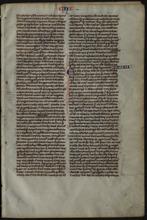
Description: "Bifolium. Manuscript on vellum, 12mo (17.7 x 23.7 cm, 7 x 9.25"). [2] fA double-page spread from a small Paris Bible. Paris was the center of Bible production in the 13th century, with the text having been standardized there, and the University attracting scholars who wished to have just such a small Bible as this double leaf came from—a new thing in the 13th century. The texts on this bifolium are Ezekiel 27:11-30:3, containing prophecies against Tyre and Egypt, and Ezekiel 44:17-47:4, with directions for restoring the life of a just and righteous Israel and the beginning of Ezekiel's vision of water pouring forth from the temple.nnThis leaf is of very fine paper-thin vellum. The text is in two columns per page of 53 lines, faintly ruled in lead, the top line written above the top rule. The outer edge of the second leaf retains its prickings. Text is written in black ink in a very small and compact Gothic script of the style typical of Bibles and other scholarly manuscripts of the 13th century. The running headers are in red and blue ink, the numbers heading each chapter are likewise in red and blue, and there are 1 ten-line initial I (in red with blue tracery), 1 four-line initial H (in blue with red tracery), and 4 two-line initials (in red or blue with tracery in the contrasting color). Key initials in the text are lined in red. Some corrections have likewise been made in the text, in black or red, and there is some marginalia in black and red in an early hand.",Full pdf available, https://dl.mospace.umsystem.edu/mu/islandora/object/mu%3A439250/datastream/PDF/view
Member of: Private Collection of Antiquarian Books and Manuscripts
Resource Type: Text
Bible. Latin. O. T. I Samuel. [leaf]
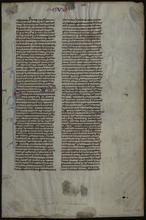
Description: 12mo (19.6 x 13.1 cm, 7.75 x 5.125"). [1] f.Paris was the center of Bible production in the 13th century, with the text having been standardized there, and the University attracting scholars who wished to have just such a small Bible as this leaf came from—a new thing in the 13th century. [BEING QUERIED: The text here is I Samuel 22:15-25:8, including the pursuit of David by King Saul and the famous scene where David sneaks up and cuts off part of the king's cloak, later showing it to Saul as proof of his good faith, that when he could have killed him, he forebore doing so.]nnThis leaf is of fine quality (i.e., thin) vellum, with the text in two columns per page of 57 lines each, ruled in lead, the top line written below the top rule. The pricking for the rules is still present on the outside edge of the leaf. The scribe has written very small in black ink in compact Gothic script of the style typical of Bibles and other scholarly manuscripts of the 13th century, though it shows a few characteristics of later cursive Gothic. The running headers are in red and blue letters with a little pen tracery. The numbers heading each chapter (XXIII, XXIIII, and XXV) are likewise in red and blue, and there are 3 two-line initials (one on the recto and two on the verso) heading each chapter, a red E, a blue A (with a long descender), and a red M, each with elaborate and long tracery in the contrasting color. There are also notes to the rubricator on the edges.nnProvenance: Ex-Zion Research Foundation (later known as the Endowment for Biblical Research); very likely to Zion from Ege. nnSome spots of staining in the margins, and remnants of adhesive with vellum thinned where it was removed.,Full pdf available, https://dl.mospace.umsystem.edu/mu/islandora/object/mu%3A439261/datastream/PDF/view
Member of: Private Collection of Antiquarian Books and Manuscripts
Resource Type: Text
Bifolium from a Book of Hours
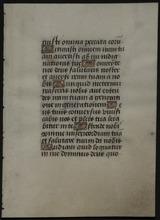
Description: Manuscript vellum bifolium (two leaves) from a book of hours. The text includes parts of the Gospel readings and some prayers. Folio 2r begins with Psalm 116:1: "Laudate Dominum omnes gentes; laudate eum omnes populi." France, late 15th or early 16th century. Batarde hand. Text in one column of 17 lines. One and two-line illuminated initials, in gold, red, violet and white. 12.7 x 9 cm. Catalogued by PRB&M (short description included with the item).
Member of: Private Collection of Antiquarian Books and Manuscripts
Resource Type: Text
Catholic Church Liturgy (fragment)
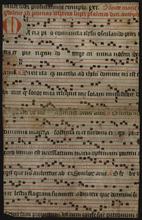
Description: A partial leaf from a liturgical manuscript on vellum, probably a church service book. The text on the recto is in a single column of 12 lines with ten 4-line staves, rule din red with neumes in black, and on the verso in a single column of 33 lines (no staves) ruled in red. The recto has text and chant of prayers for celebration of the Feast of [Saint] Mary Magdalene (22 July): the rubric reading "Sancte marie ma/gdalene ad primas vesperas super salmos diei. antyphon," (lines 1-2) and the text beginning: "Maria pio coniuncta ihesu osculando pedes..." (line 3). The verso contains a list of prayers (maunly collects?) for celebrating feasts of a number of saints and occasions, including the feasts of Saint Peter and Saint Paul. The text is written in a Gothic textura book hand of good quality in two grades of formality: the text on the recto and that of larger size on the verso is written in the slightly less formal textualis semi-quadrata. There is frequent use of abbreviations including both contractions and suspensions. The music for the chant is written in neumes. The recto has a single larde initial "M" in red (the height of one stave plus one line) marking the opening of the chant for "Maria pio communita oscilando..." and on the verso are six large 2-line initials in alternating red and blue. This leaf was used as binding waste in making up a volume half its size, to which end it was heavily cut down to a size just smaller that the text block and rotated horizontally. A crease running horizontally accross the middle of the leaf shows the mark of the spine of the volume. (description provided by seller)
Member of: Private Collection of Antiquarian Books and Manuscripts
Resource Type: Text
Commentary on Peter Lombard's Sentences, with the Abridgement of the Sentences.
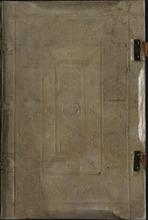
Description: 148 leaves (including fly), complete, collation: i- xv10, xvi7 (first leaf a singleton added to complete text, but text continuous – compare the online photographs of Yale, Beinecke MS. 1079, fols. 196r-197v; this gathering includes three endleaves and the rear pastedown), contemporary catchwords and modern pencil pagination on lower corners of rectos, Latin text in double columns of 18 lines (main text generously spaced) with commentary in smaller script set within blocks filling entire sections of columns or smaller rectangular part (see below), rubrics in dark red-burgundy, paragraph marks in red, running titles in same at head of each page, small initials in red or blue (some with purple or red contrasting penwork). Four illuminated initials in blue, green or dark pink acanthus leaf fronds, enclosing other foliage on burnished gold grounds, single hairline foliage and acanthus leaf sprays in margin, terminating in gold bezants and ivy-leaves and long pointed fruit, encased in penstrokes giving them a distinctive 'hairy' appearance (similar to borderwork on early fifteenth-century Books of Hours and liturgical books, compare L.M.C. Randall, Medieval and Renaissance Manuscripts in the Walters Art Gallery, II: France, 1420-1540, 1992, figs. 197, 199, 201 and 203, all Parisian or northern French first half of fifteenth century). Many marginal and interlinear additions by main hand, a little flaking to opening initial, one or two leaves with small splashes, a few small marginal wormholes, good margins, generally excellent condition. In sixteenth-century blindstamped pigskin boards bevelled in their mid-sections in German style, and tooling of panels of Tudor rose style flower heads and small flowers, binding skilfully restored, traces of metal clasps at fore-edge. Overall, a high quality and elegantly produced ms in excellent and crisp condition.nn"A very fine copy of a fundamentally important medieval text, yet to be edited or extensively studied; and most probably the sole copy to appear on the open market since records began.nnProvenance:nn1. Written and illuminated, most probably for a monastery or cathedral school in eastern France, in the fifteenth century. Bound or rebound with bevelled boards in the German fashion, in the sixteenth century.nn2. In French-speaking ownership in the nineteenth century, with notes on the date of the codex and its contents on front pastedown and front flyleaf.nn3. Alexis Noisilier of Paris: his 1929 printed bookplate to front pastedown.nnPeter Lombard's Sentences was a fundamental compilation that provided the medieval Church with a comprehensive framework for theological and philosophical discussion. It ranks among the most important works of the Middle Ages, and among the handful of commentaries that the thirteenth century produced, that of Hugh of Saint Cher (d. 1263), a French Dominican friar, holds a commanding position. It steered and guided study of Lombard's work for several generations, making itself felt in the works of John of Treviso, the anonymous abbreviation Filia Magistri, the commentary of Richard Fishacre, among others, and most probably contributed to the development of a new type of commentary (see M. Bieniak, 'The Sentences Commentary of Hugh of St.-Cher', in Mediaeval Commentaries on the Sentences of Peter Lombard, 2009, ed. P.W. Rosemann). It is particularly surprising that there is no edition of the text, and only two partial studies of its manuscript tradition – focussing only on the thirteenth-century witnesses (T. Kaeppeli, Scriptores Ordinis Praedicatorum Medii Aevi, 1975, II, p. 272, no. 1983, and IV, p. 125; updated by B. Faes de Mottoni, 'Les manuscrits du commentaire des Sentences d'Hugues de St. Cher', in Hugues de Saint-Cher († 1263) bibliste et theologien, ed. L.-J. Bataillon et al., 2004, pp. 273-98, listing 41 manuscript commentaries – all in European institutions; save a thirteenth-century Spanish at Yale, Beinecke MS. 1079).nnA contemporary hand has added at the end the erroneous note that it was "Abbreviatus ut credunt per M[agister] Alexander de halis", linking its authorship to the English Franciscan writer, Alexander de Hales (d. 1245), which might provide for future scholarship. Faes de Mottoni notes the glosses of this English Franciscan are found alongside those of Hugh of Saint Cher in the crucial early witness of the text in Stockholm, Kungliga Bibliotheket, MS. A 150, a thirteenth-century Parisian witness, which gives all four books of the Sentences in their full form, with the commentary in the margins, and has been identified as an authorial related copy of the work by F. Stegmüller ('Die älteste Redaktion des Senten zenkommentars Hugos von St. Cher in einer Handschrift der königlichen Bibliothek zu Stockholm', Nordisk Tidskrift för Bok- och Biblioteksväsen, 35 (1948), p. 69-79; and the same author's 'Die endgültige Redaktion des Sentenzenkommentars Hugos von St. Cher', Classica et mediaevalia, 9 (1948), pp. 246-265) see also W. H. Principe, 'Hugh of Saint-Cher's Stockholm 'Gloss on the Sentences': An Abridgment rather than a First Redaction', Mediaeval Studies, 25 (1963), pp. 372-376, and J. Gründel, 'Hugo von St. Cher O.P. und die älteste Fassung seines Sentenzenkommentars', Scholastik, 39 (1964), pp. 392-401, for opposing views. If comparison of the commentaries in the Stockholm manuscript and the present links them textually, our copy would be particularly important for knowledge of the history and use of the text in later medieval France.nnThis is thought to be Hugh of Saint Cher's first work, and he is known to have lectured on the Sentences at the University of Paris in 1226-1227, 1229-1230 and perhaps also 1230-1231. It is in fact two texts: a complete abridgement of the entire Sentences (hence the work is sometimes, inaccurately, called an epitome), as well as the commentary itself. Moreover, it is notable that the commentary here is set in smaller script in smaller blocks occupying the whole or sections of the text columns in a way clearly derived from the arrangement of glossed books of the Bible by Parisian book-producers in the twelfth and thirteenth centuries (see C. de Hamel, Glossed Books of the Bible and the Origins of the Paris Booktrade, 1984). While such a format is absent from some early witnesses (such as the Stockholm manuscript), it is found in others, such as the Yale copy, which presents the similar text and commentary in a near identical format. Clearly this 'Glossed Bible' format has its origins in the earliest history of the text, and thorough study of the surviving witnesses would probably reveal families and patterns. The present ms stands as an important record of the continuing use of this format into the fifteenth century.nnThe work itself is of breath-taking rarity on the market, with the vast Schoenberg database listing only one possible copy: offered for sale by B. Rosenthal, cat. 1 (1954), no. 5 (although its small size there suggests that it was in fact a copy of the Filia Magistri – as was the text of the same title offered online by Les Enlumineres, their TM 905, in 2019). The Beinecke bought theirs from an undeclared and possibly private source in 1920. Thus, the present copy would appear to be the sole copy of this important text to appear on the market since records began.
Member of: Private Collection of Antiquarian Books and Manuscripts
Resource Type: Text
